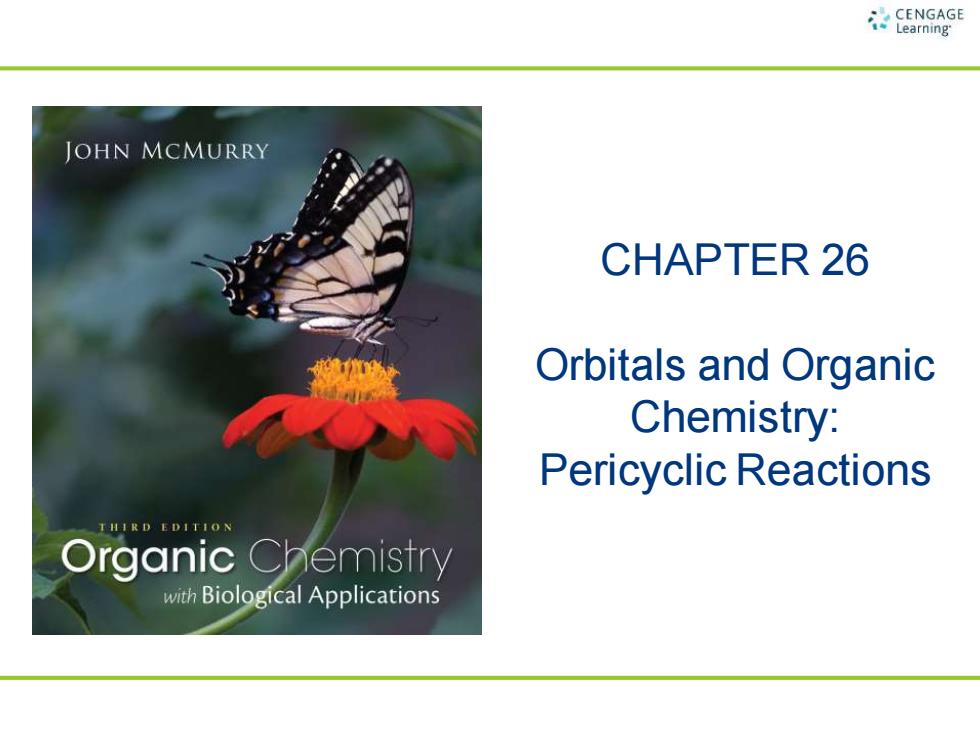
CNGNGE JOHN MCMURRY CHAPTER 26 Orbitals and Organic Chemistry: Pericyclic Reactions H IRD EDITION Organic Chemistry with Biological applications
CHAPTER 26 Orbitals and Organic Chemistry: Pericyclic Reactions

Pericyclic Reactions -What Are They? Pericyclic reaction All bonding changes occur simultaneously through a cyclic transition state The combination of steps is called a concerted process; no intermediates are involved Why this chapter? Understanding of pericyclic reactions emerged in the latter half of the twentieth century Some biological pathways proceed through pericyclic reactions
Pericyclic reaction • All bonding changes occur simultaneously through a cyclic transition state • The combination of steps is called a concerted process; no intermediates are involved Why this chapter? • Understanding of pericyclic reactions emerged in the latter half of the twentieth century • Some biological pathways proceed through pericyclic reactions Pericyclic Reactions – What Are They?
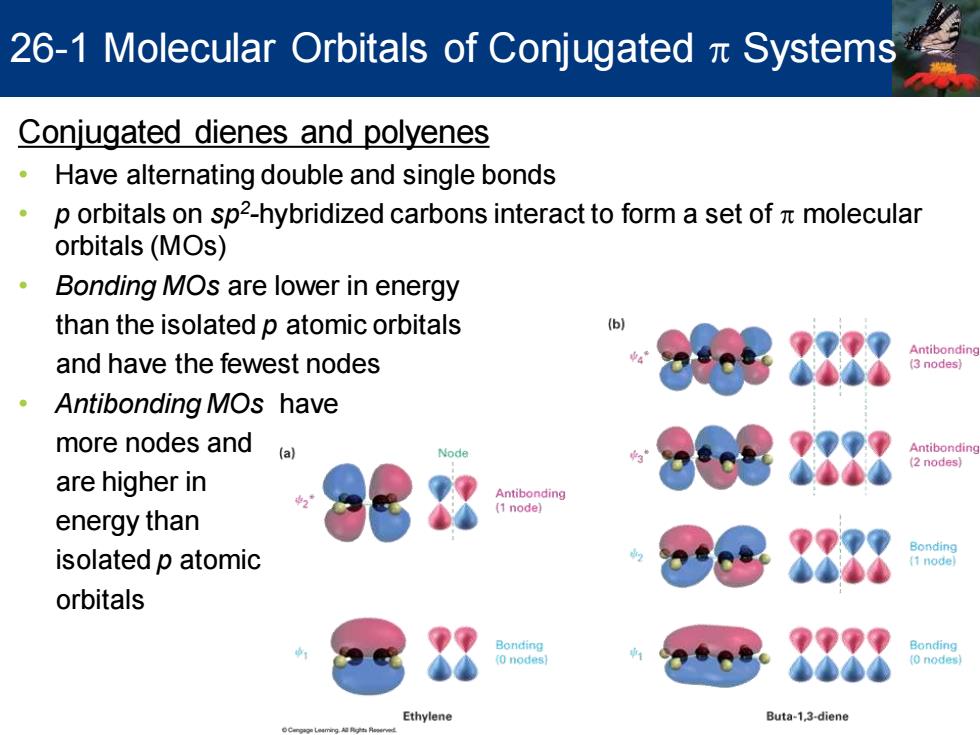
26-1 Molecular Orbitals of Conjugated Systems Conjugated dienes and polyenes Have alternating double and single bonds 。 p orbitals on sp2-hybridized carbons interact to form a set of molecular orbitals(MOs) 。 Bonding MOs are lower in energy than the isolated p atomic orbitals b Antibonding and have the fewest nodes 3 nodes ·Antibonding MOs have more nodes and (a) Antibonding 2 nodes) are higher in Antibonding (1 node) energy than isolated p atomic orbitals Bonding Bonding 0 nodes (0 nodes Ethylene Buta-1,3-diene
Conjugated dienes and polyenes • Have alternating double and single bonds • p orbitals on sp2 -hybridized carbons interact to form a set of p molecular orbitals (MOs) • Bonding MOs are lower in energy than the isolated p atomic orbitals and have the fewest nodes • Antibonding MOs have more nodes and are higher in energy than isolated p atomic orbitals 26-1 Molecular Orbitals of Conjugated p Systems
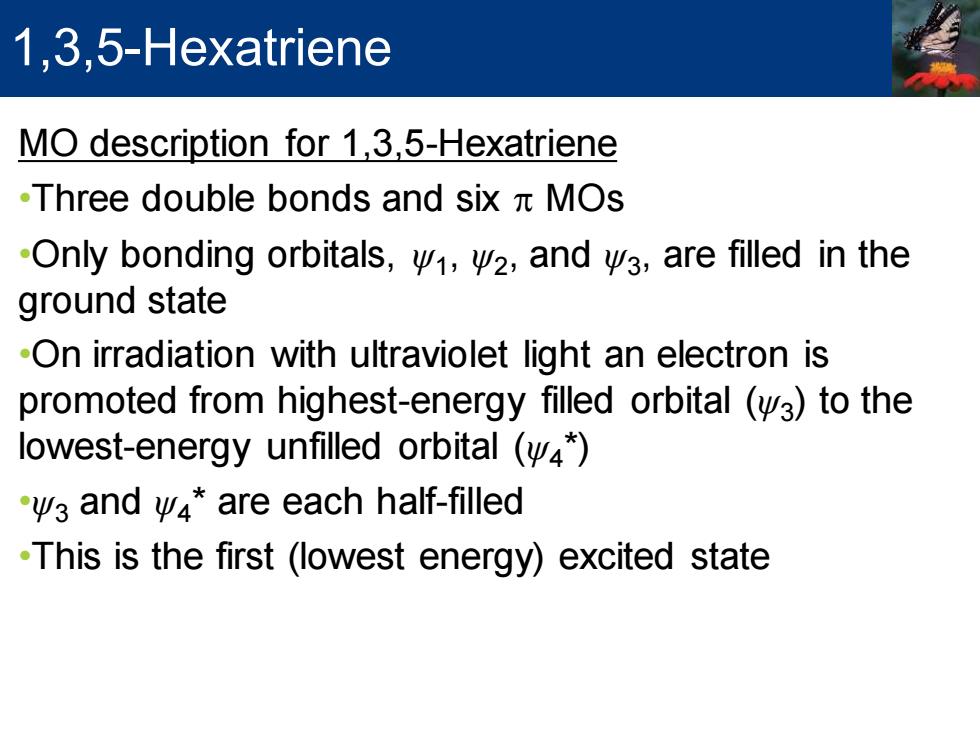
1,3,5-Hexatriene MO description for 1,3,5-Hexatriene -Three double bonds and six MOs -Only bonding orbitals,,w2,and wa,are filled in the ground state -On irradiation with ultraviolet light an electron is promoted from highest-energy filled orbital (y3)to the lowest-energy unfilled orbital (* Va and are each half-filled .This is the first (lowest energy)excited state
MO description for 1,3,5-Hexatriene •Three double bonds and six p MOs •Only bonding orbitals, ψ1 , ψ2 , and ψ3 , are filled in the ground state •On irradiation with ultraviolet light an electron is promoted from highest-energy filled orbital (ψ3 ) to the lowest-energy unfilled orbital (ψ4 *) •ψ3 and ψ4 * are each half-filled •This is the first (lowest energy) excited state 1,3,5-Hexatriene
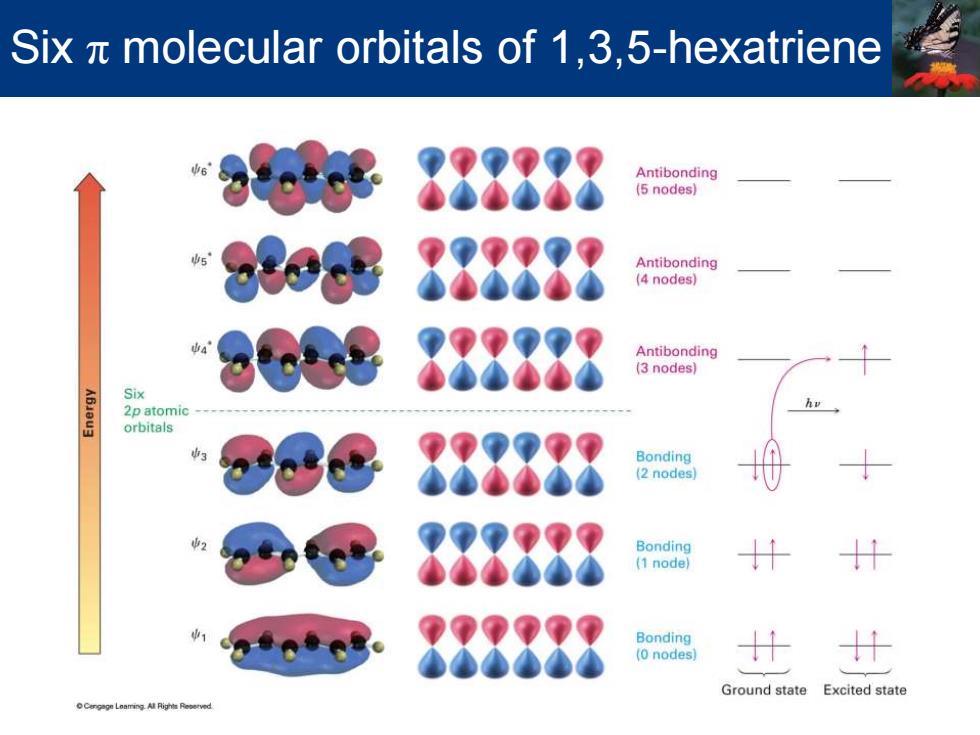
Six x molecular orbitals of 1,3,5-hexatriene 888888 Antibonding (5 nodes) 888888 Antibonding (4 nodes) 888888 Antibonding (3 nodes) Six 2p atomic orbitals Bonding (2 nodes) 888 Bonding 888888 Bonding (0 nodes 计 Ground state Excited state
Six π molecular orbitals of 1,3,5-hexatriene
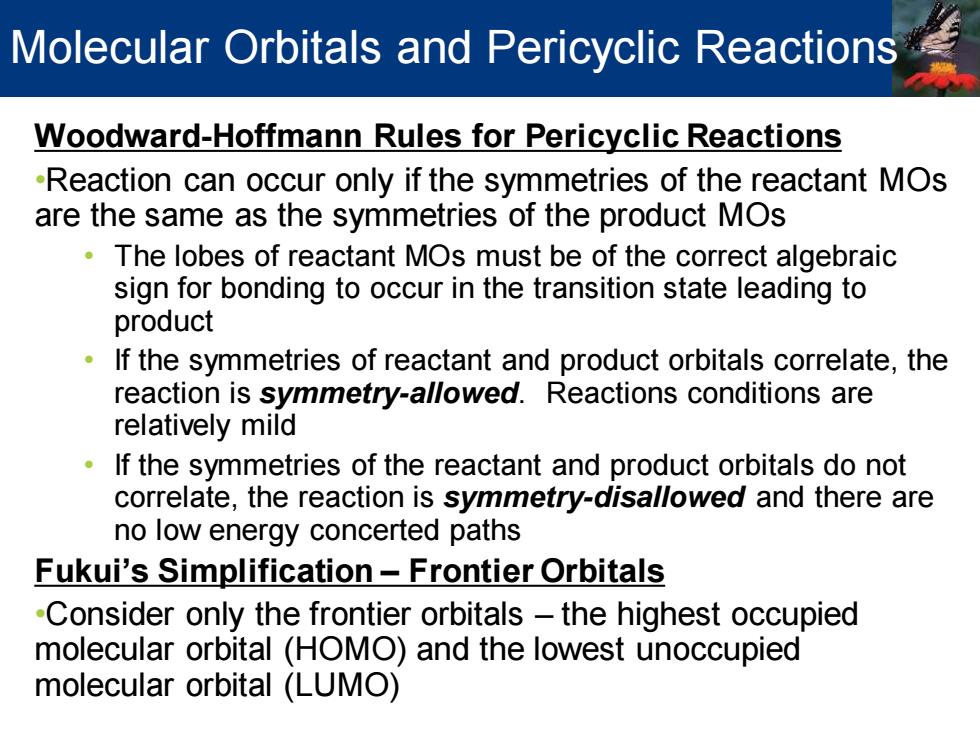
Molecular Orbitals and Pericyclic Reactions Woodward-Hoffmann Rules for Pericyclic Reactions -Reaction can occur only if the symmetries of the reactant MOs are the same as the symmetries of the product MOs The lobes of reactant MOs must be of the correct algebraic sign for bonding to occur in the transition state leading to product If the symmetries of reactant and product orbitals correlate,the reaction is symmetry-allowed.Reactions conditions are relatively mild If the symmetries of the reactant and product orbitals do not correlate,the reaction is symmetry-disallowed and there are no low energy concerted paths Fukui's Simplification Frontier Orbitals -Consider only the frontier orbitals-the highest occupied molecular orbital (HOMO)and the lowest unoccupied molecular orbital (LUMO)
Woodward-Hoffmann Rules for Pericyclic Reactions •Reaction can occur only if the symmetries of the reactant MOs are the same as the symmetries of the product MOs • The lobes of reactant MOs must be of the correct algebraic sign for bonding to occur in the transition state leading to product • If the symmetries of reactant and product orbitals correlate, the reaction is symmetry-allowed. Reactions conditions are relatively mild • If the symmetries of the reactant and product orbitals do not correlate, the reaction is symmetry-disallowed and there are no low energy concerted paths Fukui’s Simplification – Frontier Orbitals •Consider only the frontier orbitals – the highest occupied molecular orbital (HOMO) and the lowest unoccupied molecular orbital (LUMO) Molecular Orbitals and Pericyclic Reactions
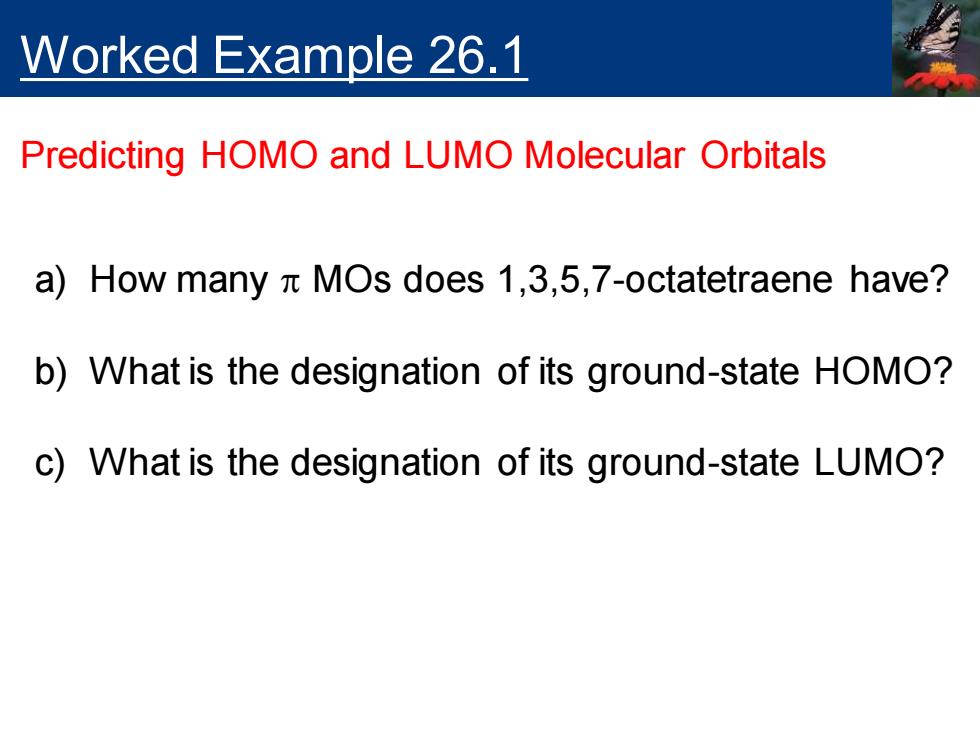
Worked Example 26.1 Predicting HOMO and LUMO Molecular Orbitals a)How many n MOs does 1,3,5,7-octatetraene have? b)What is the designation of its ground-state HOMO? c)What is the designation of its ground-state LUMO?
Worked Example 26.1 Predicting HOMO and LUMO Molecular Orbitals a) How many p MOs does 1,3,5,7-octatetraene have? b) What is the designation of its ground-state HOMO? c) What is the designation of its ground-state LUMO?
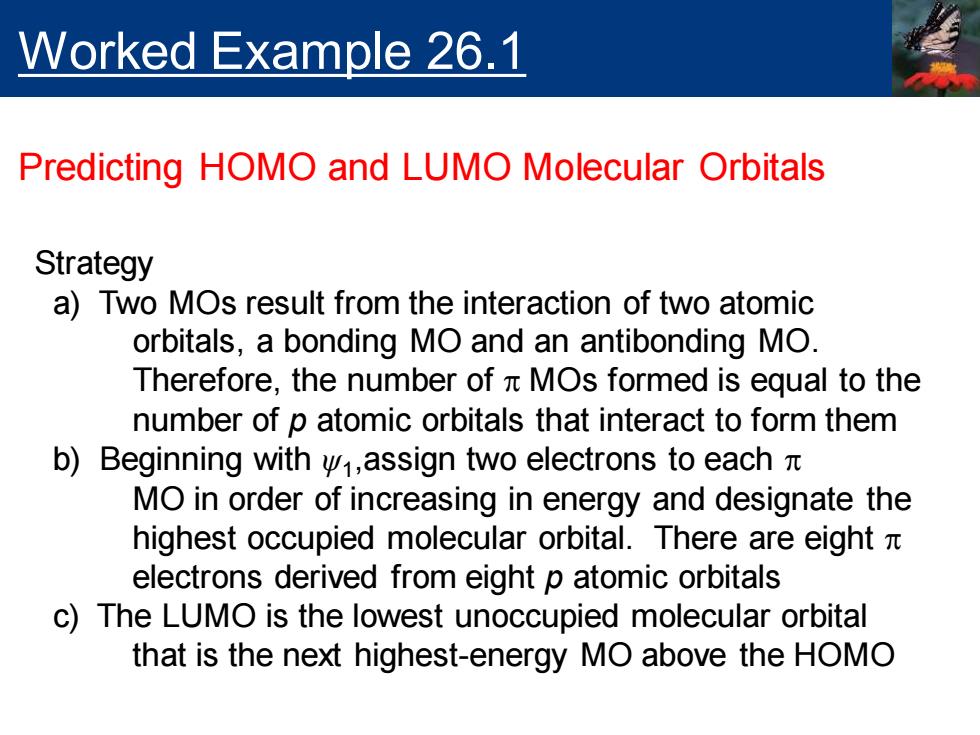
Worked Example 26.1 Predicting HOMO and LUMO Molecular Orbitals Strategy a)Two MOs result from the interaction of two atomic orbitals,a bonding MO and an antibonding MO. Therefore,the number of n MOs formed is equal to the number of p atomic orbitals that interact to form them b)Beginning with v,assign two electrons to each MO in order of increasing in energy and designate the highest occupied molecular orbital.There are eight x electrons derived from eight p atomic orbitals c)The LUMO is the lowest unoccupied molecular orbital that is the next highest-energy MO above the HOMO
Worked Example 26.1 Predicting HOMO and LUMO Molecular Orbitals Strategy a) Two MOs result from the interaction of two atomic orbitals, a bonding MO and an antibonding MO. Therefore, the number of p MOs formed is equal to the number of p atomic orbitals that interact to form them b) Beginning with ψ1 ,assign two electrons to each p MO in order of increasing in energy and designate the highest occupied molecular orbital. There are eight p electrons derived from eight p atomic orbitals c) The LUMO is the lowest unoccupied molecular orbital that is the next highest-energy MO above the HOMO
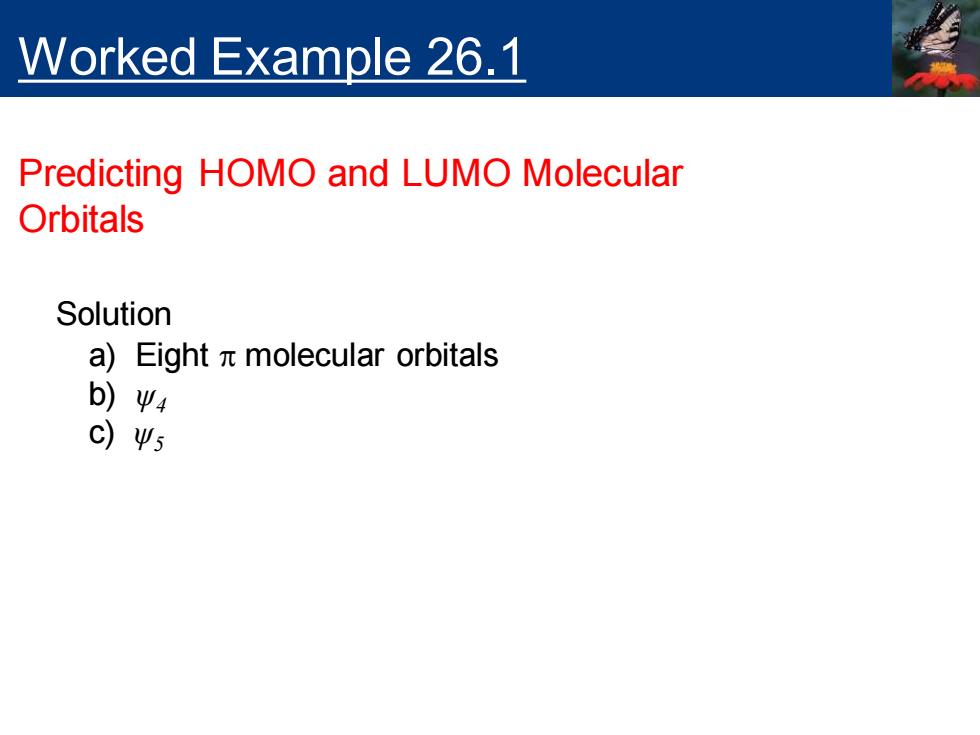
Worked Example 26.1 Predicting HOMO and LUMO Molecular Orbitals Solution a)Eight n molecular orbitals b)Ψ4 c)Ψ5
Worked Example 26.1 Predicting HOMO and LUMO Molecular Orbitals Solution a) Eight p molecular orbitals b) ψ4 c) ψ5
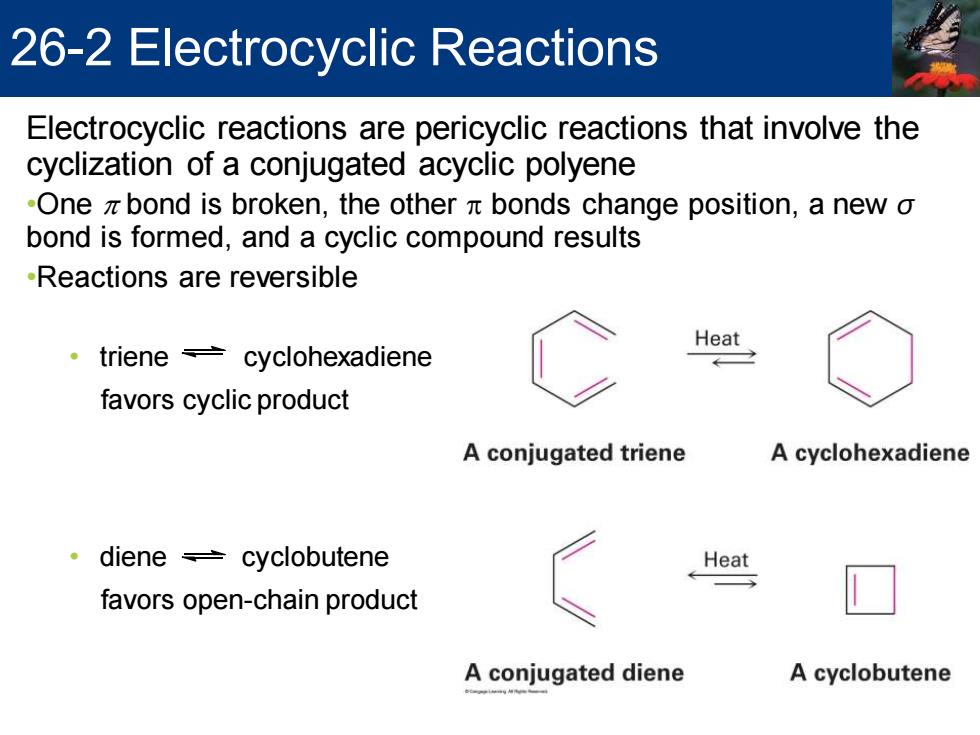
26-2 Electrocyclic Reactions Electrocyclic reactions are pericyclic reactions that involve the cyclization of a conjugated acyclic polyene -One z bond is broken,the other x bonds change position,a new o bond is formed,and a cyclic compound results -Reactions are reversible Heat triene cyclohexadiene favors cyclic product A conjugated triene A cyclohexadiene ·diene≠cyclobutene Heat favors open-chain product A conjugated diene A cyclobutene
Electrocyclic reactions are pericyclic reactions that involve the cyclization of a conjugated acyclic polyene •One p bond is broken, the other p bonds change position, a new σ bond is formed, and a cyclic compound results •Reactions are reversible • triene cyclohexadiene favors cyclic product • diene cyclobutene favors open-chain product 26-2 Electrocyclic Reactions